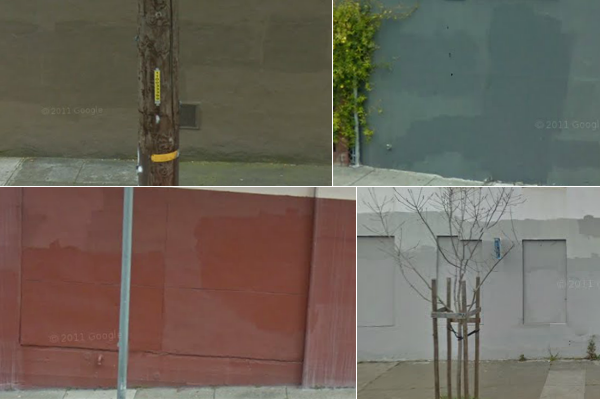Random
Finding Rothko

On February 25, 1970, Mark Rothko was found dead in his studio covered in blood with a razor next to him. Forty-two years later, his death would be used somewhat manipulatively to garner attention from likely readers. Last weekend, the author would have been reminded of our painter upon seeing noncommittal blotches of paint applied with a roller around his neighborhood. He would have taken pictures, perhaps even instagrammed them, but didn’t want to be one of those assholes taking pictures of urban oddities for artistic purposes, so he retraced his footsteps in Google streetview later on that week, at work, to find said moments — though he would admit that this notion was not entirely his, pointing to a short documentary The Subconscious Art of Graffiti Removal (2002), which proposed similar relationships between the subtleties of abstract painting and the residual inadvertent inconsistencies in tone and hue caused by aggregate layers of similar-ish paint in the covering of graffiti. And it would not be hard to begin talking about class, how some marks are cordoned off in museums, whereas others are left to perish or prosper in public entropy. (Some socioeconomically disenfranchised kids asserted power in the true democracy of space: on the side of a building, for all to see their name, or the gang to which they belonged. Or, they are simply punks from good families, and the immigrant worker most likely tasked with a paint roller and approximate bucket is the silenced subordinate.) It’s funny how we place both the Cross and painting on the wall, embarrassed — at least I am — at the loud hammer upon the nail from which they hang. I majored in Art, and minored in not being realistic. Rothko’s manhood was left impotent by an aneurism, his other manhood — what we’ll call “legacy” — left inside his eponymous chapel by a Texan millionaire giving philanthropy a go. The Rothko Chapel is non-denominational, as no one wants to argue with the dead. Rothko was involved in its design, wanting it windowless, save an unblinking skylight above. Perhaps those dark purple paintings, the slow bruise over a career that lacked the egoism of his peers, retained of any form save the canvas’ dimensions themselves, were to be windows elsewhere.

Rothko is my favorite artist. I don’t know, cheers for writing this Jimmy.
Always been interested in Rothko, but it took a visit to Turrell in Dallas to give me some perspective. Here’s the essay, probably my first online about art: http://theopenend.com/2010/07/20/cold-spaces-rothko-chapel-tending-blue/
This is a fantastic post, thanks. I’ve always struggled to reconcile the conflict you raised, particularly that
“Some socioeconomically disenfranchised kids asserted power in the true democracy of space: on the side of a building, for all to see their name, or the gang to which they belonged. Or, they are simply punks from good families, and the immigrant worker most likely tasked with a paint roller and approximate bucket is the silenced subordinate.”
My biography, which I won’t indulge in telling, treads this tight-rope. The only provisionally justifiable recourse is the structural snuffing out of both, through the keeping busy of both the worker–immigrant or not– and the worker’s desperately creative youth, the making enemies out of your dissenters, so to speak.
Speaking of so-to-speak, I will now gaze with ever more attention to the presences snuffed out beneath the layers of primer, refusing to hush. Thank you.
tinyurl.com/73huk6r